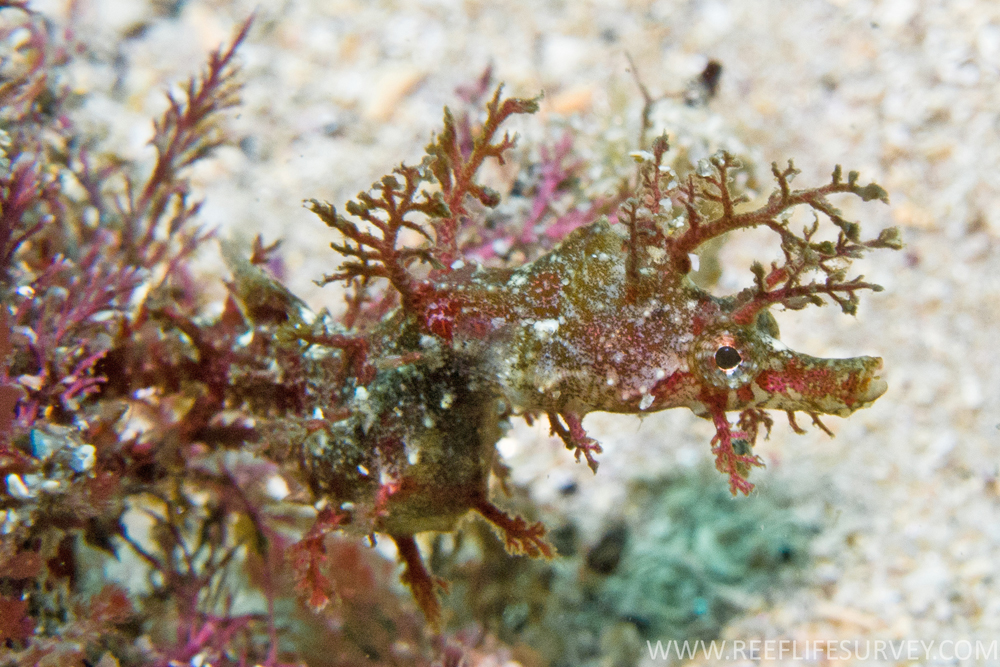Sydney’s Pygmy Pipehorse, Idiotropiscis lumnitzeri Kuiter 2004

Sydney’s Pygmy Pipehorse, Idiotropiscis lumnitzeri - Sydney, New South Wales. Source: Thierry Rakotoarivelo / Reef Life Survey. License: All rights reserved
This tiny pipehorse is so small and well-camouflaged that it is rarely seen by divers. It lives on rocky reefs covered in red algae and bryozoans, using its prehensile tail to cling to vegetation and other structures.
The skin of Sydney’s Pygmy Pipehorse is often covered in algae that provides very effective camouflage within its habitat.
Video of a pair of Sydney's Pygmy Pipehorse mating.
Video of Sydney’s Pygmy Pipehorse.
Sydney’s Pygmy Pipehorse, Idiotropiscis lumnitzeri Kuiter 2004
More Info
|
Distribution |
Endemic to New South Wales, from Cabbage Tree Bay, Manly, to at least Bawley Point, New South Wales. Inhabits semi-exposed rocky reefs covered in clumps of red algae or bryozoans at depths to 30 m. Individuals appear to be site-attached, remaining on the same small reef areas for much of the year. |
|
Features |
Dorsal fin 15–16; Pectoral fin 13.Trunk rings 11; tail rings 43–44. Head large, length 86–91% of trunk length and angled ventrally approximately 25° from longitudinal axis of body; snout short, length 2.2–2.6 in head length; snout depth 46% (45–47%) of its length; top of head with prominent, tall, frontal ridge originating well behind eye, with thick, long, branched, fleshy dermal appendage, reaching forward to above tip of snout; trunk length 18–20% TL; numerous simple to fern-like branched, fleshy dermal appendages on head and body, well-developed above eye, under snout and at various intersections of rings and superior ridges on trunk and tail; trunk very deep, its greatest depth 73% of its length; superior trunk-ridge ending below dorsal-fin base, above origin of superior tail-ridge; tail prehensile. Dorsal-fin base arched upwards at centre. |
|
Size |
To 5.5 cm TL |
|
Colour |
Overall whitish to reddish or dark grey, with brown to reddish blotches or irregular banding; sometimes uniformly burgundy-red. Fleshy appendages are mostly red with grey 'branches' or tips. |
|
Feeding |
Feeds on tiny crustaceans. |
|
Biology |
Males brood about 60 eggs in a large brood pouch on the underside of the trunk before giving birth to live young. |
|
Fisheries |
The species is fully protected. |
|
Conservation |
IUCN Red List: Least Concern EPBC Act 1999: Marine listed NSW: Listed as protected under the New South Wales Fisheries Management Act. |
|
Remarks |
The skin of I. lumnitzeri is specialised to encourage the growth of the algae it lives amongst, and algae often covers the rings and plates of the body. The algal covering provides very effective camouflage within its habitat. Some individuals monitored over an eight-year period, were observed to live on the same small sections of reef for long periods, up to about 8 months. Individuals occur singly, in pairs or in small groups at night. |
|
Similar Species |
|
|
Etymology |
|
|
Species Citation |
Idiotropiscis lumnitzeri Kuiter 2004, Rec. Aust. Mus. 56: .164, figs 1-2. Type locality: Henrietta Head, La Perouse, Sydney, New South Wales, Australia, 34°00'S, 151°15'E, depth 22 m. |
|
Author |
Bray, D.J. 2022 |
|
Resources |
Sydney’s Pygmy Pipehorse, Idiotropiscis lumnitzeri Kuiter 2004
References
Kuiter, R.H. 2000. Seahorses, Pipefishes and Their Relatives. Chorleywood, UK : TMC Publishing 240 pp.
Kuiter, R.H. 2004. A New Pygmy Pipehorse (Pisces: Syngnathidae: Idiotropiscis) from Eastern Australia. Records of the Australian Museum 56: 163-165 https://doi.org/10.3853/j.0067-1975.56.2004.1420
Kuiter, R.H. 2009. Seahorses and their relatives. Seaford, Australia : Aquatic Photographics 331 pp.
Rachinski, T. & Pollom, R. 2016. Acentronura lumnitzeri (errata version published in 2017). The IUCN Red List of Threatened Species 2016: e.T65369051A115424796. http://dx.doi.org/10.2305/IUCN.UK.2016-3.RLTS.T65369051A67618758.en. Downloaded on 18 October 2018.
Teske, P. & Beheregaray, L. 2009. The Rise of Seahorses. Australasian Science (Nov-Dec): 24-25
Teske, P.R. & Beheregaray, L.B. 2009. Evolution of seahorses' upright posture was linked to Oligocene expansion of seagrass habitats. Biology Letters 5: 521-523








